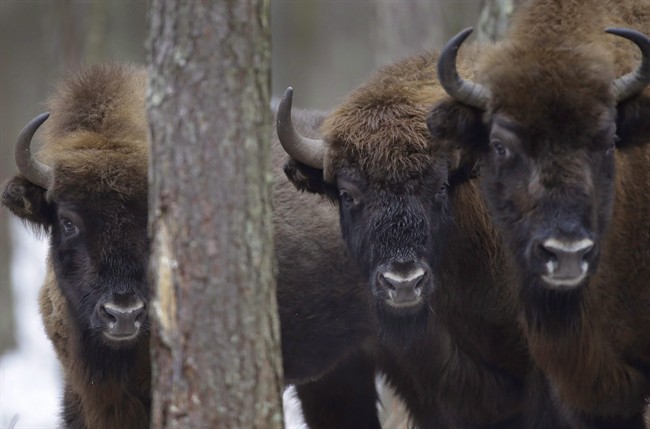EDMONTON – Scientists finally have been able to pin down when bison first arrived in North America and helped set the stage for the Great Plains that eventually supported the continent’s first humans.

“(Bison) showed up and they interrupted an ecosystem that had existed, more or less, for a million years,” said Duane Froese, a University of Alberta earth scientist and lead author of a paper published Monday. “The stage was set for North America.”
READ MORE: Bison re-introduction in Banff National Park gets support from North American experts
Bison are one of the most successful species ever to inhabit the prairies and have been so for a long time. Their fossils are so common that scientists use them to help date other fossils.
“When you found bison bones in a bunch of fossils, you knew this was a relatively young assemblage,” Froese said.
But no one had been able to fix when bison first crossed over from Siberia and began competing with the woolly mammoths and horses that dominated the continent.
Froese and his international colleagues began with two fossils — a 130,000-year-old sample from Yukon and another one about 10,000 years younger and a slightly different species from Colorado. They wanted to see if they could use a type of DNA extracted from the fossils to determine if the two had a common ancestor.
READ MORE: Federal government announces bison returning to Banff National Park
Using a set of well-dated bison fossils, the team calculated the rate of genetic change for bison. They projected that rate backwards to determine when the first bison evolved — what Froese calls “the mother of all bison.”
That method produced a range of between 195,000 and 135,000 years ago.
READ MORE: Royal Alberta Museum to crack open 1,600-year-old roasting pit with meal still inside
Comparing that range to when sea levels were low enough for animals to cross the land bridge between North America and Asia yielded a date for the first bison on this continent of about 130,000 years ago — roughly the same age as the Yukon fossil.
Bison became so common, so quickly, that scientists speculate they actually changed the ecology.
“They became the keystone herbivore of the Great Plains,” said Froese. “They probably out-competed horses and mammoths.”
Both animals eventually became extinct in North America.
The bison also may have brought new predators with them. Froese said animals such as lions probably followed the bison across the land bridge.
RELATED: Elk Island bison begin journey ‘home’ to Blackfeet Nations reserve
With great herds of bison roaming across the plains, the ecosystem itself thrived.
“The interglacial prairies that we know today are probably the most productive prairies that we ever had.”
It was a welcoming environment for the first humans, who came to North America about 14,000 years ago.
“Those people would have come into North America when mammoths and horse and bison were still co-existing,” Froese said.
“But they entered into an ecosystem where bison were doing quite well, so they were a big protein source for early North Americans. We really developed in much of North America an economy based on bison hunting.”

Comments